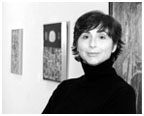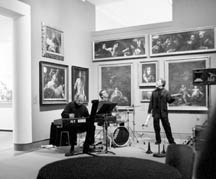
 |
| Susan M. Taylor, director of the art museum, in the Peter B. Lewis Gallery. (Photo: Denise Applewhite) |
The University Museum: The Art of Campus Life
Susan M. Taylor became the director of the Princeton University Art Museum in the summer of 2000. Since that time, the museum has held major exhibitions, reinstalled several galleries, acquired important new works of art, expanded availability of its collect-ions, and initiated programs to attract students to the museum. In conjunction with this special issue of PAW focused on campus life, I thought you would enjoy learning more from her about the many and varied ways the museum is enriching the life of the University community. — Shirley M. Tilghman
Art education is not a visionary, imaginary subject. It is education for the practical every-day life of the student in College and after he leaves College.” Thus wrote William Cowper Prime, Class of 1843, who in 1882 was charged by then President McCosh to form a curriculum in art and archaeology. His publication, Suggestions on the Establishment of a Department of Art Instruction in the College of New Jersey, made clear that he could not conceive of a department of art and archaeology that did not give students access to original works of art. He wrote, “Our visible civilization and social surroundings consist of the works of beautiful art. It is these which mark the difference between civilized and barbaric conditions. Our commerce, trade, our commercial industries, our manufactures and wealth, are dependent, not alone on the useful arts, but perhaps in vastly larger measure on beauty-producing art.... Art education is therefore practical education, for practical life.”
 |
|
First Fridays—exhibition openings especially for students—feature gallery talks by students, refreshments, and music. (Photo: John W. Wheeler)
|
In good part thanks to Prime's efforts, the Department of Art and Archaeology and the art museum were founded concurrently, and over the years the art museum has deepened its overall commitment to the education mission of the University. As a university museum we have unique opportunities—and responsibilities—to serve the Princeton community as a catalyst for research, teaching, and learning. As knowledge expands and as new inter-disciplinary programs emerge, study of the museum's collections plays an even more critical role in rigorous academic inquiry.
Take as a “prime” example the museum's association with the Department of Art and Archaeology. Today the museum shares an entrance to McCormick Hall with the department, but its ties transcend mere physical proximity. The collection and programs are influenced by and reflect the research interests of members of the department, faculty, and students alike. The Italian Renaissance City: Selections from Princeton University Collections, for example, was inspired by an international symposium on art, architecture, and civic identity organized by art and archaeology professors John Pinto and Patricia Fortini Brown with participation by members of the Departments of Comparative Literature and History. Featuring loans from the University's collections of rare books, maps, and manuscripts in Firestone Library and Marquand Library of Art and Archaeology, as well as selections from the museum's extensive 16th-century European holdings, the exhibition highlights the various aspects of the Italian Renaissance city that fascinated artists, architects, topogra-phers, military engineers, and theorists. Each of the objects on view is in and of itself beautiful, but what they tell us about Renaissance ideas on city building and the organization of private and public spaces—why Renais-sance urban planning “worked”—can still be applied today. Graduate student and exhibition coordinator Anna Swartwood, working closely with her adviser, Professor Brown, wrote the accompanying brochure.
While we continue to maintain and strengthen our ties to the Department of Art and Archaeology, we also believe that the museum should be able to engage all members of the University. Two recent efforts to extend the reach of the museum to other University departments were the exhibitions, Cézanne in Focus: Watercolors from the Henry and Rose Pearlman Collection and The Art of Structural Design: A Swiss Legacy. The Cézanne presentation in 2002 of a group of rarely exhibited watercolors offered the opportunity for interdisciplinary collaboration that not only celebrated Cézanne's genius but also used his art and life as a point of departure for new artistic investigations. With the Depart-ment of Music, the museum sponsored the performance of a contemporary chamber opera, Cézanne's Doubt, and presented the premiere of the documentary film In Search of Cézanne, directed by Allan Miller. The catalogue was the first scholarly publication on the watercolors and included introductory essays by leading scholars and in-depth entries by graduate students in the Department of Art and Archaeology.
The Art of Structural Design in 2003 celebrated the work of Gordon Y. S. Wu Professor of Engineering David P. Billington '50. For more than 45 years, Professor Billington has taught Princeton students the principles of structural engineering, emphasizing the importance of aesthetics and beauty as they relate to function. The exhibition featured the work of four influential Swiss engineers, which was represented by scale models built by Princeton undergradu-ate and graduate engineering students. Photography and interactive computer models, developed in collaboration with the Educational Testing Center of the University's Office of Information Technology, completed the exhibition, giving visual form to Billington's research and principles.
The museum's responsibilities to the campus are not defined solely by special projects and exhibitions. Some of the most satisfying educational experiences are the everyday use of the museum by classes in art and archaeology as well as other departments that have discovered the opportunities the collections hold for teaching. This semester, visitors to the museum included students in a freshman seminar taught by Assistant Professor of Classics Constanze Güthenke, “The Mediterranean and Its Travelers,” as well as Assistant Professor Peter Silver's junior history seminar, “The Eighteenth Century and the Long Revolution.” The Princeton University Art Museum stands apart from many American university museums by virtue of its encyclopedic collection of world-renowned holdings representing all eras of human history, from ancient to contemporary, and all media, from early sculpture to 21st-century video. We are expanding the availability of these important collections, including the rich collections of prints and drawings that are not always on view, and we want to encourage faculty to take advantage of these remarkable resources for, as Prime so accurately said, “Their study is the study of man in all times.”
Our bridges also cross Nassau Street to local communities. We are fortunate
to have a committed docent group that participates actively in the education
mission of the museum. Through programs designed to introduce young children
and families to art, as well as public lectures and gallery talks, we
hope to encourage members of the broader Princeton community to visit
the museum. Exhibitions are often covered by local media and the New
York Times; in part because of highly favorable reviews, the current
exhibition The Centaur's Smile: The Human Animal in Early Greek Art has
resulted in a record number of visitors.
In many ways, The Centaur's Smile is a paradigm of the scholarly
opportunities that result from identifying connections among the collections,
the curriculum, and research opportunities, and it is a reaffirmation
of the museum's commitment to presenting the permanent collection within
the context of new research and scholarship. In 1997 one of the finest
surviving Greek bronzes in the world, a late-sixth-century b.c. statuette
of a centaur, entered the permanent collection of the museum. This extraordinary
work was the inspiration for a seminar in 1999 on Mischwesen—composite
creatures comprised of both human and animal elements—taught by J.
Michael Padgett, curator of ancient art, and William A. P. Childs, professor
of art and archaeology, using objects from the collection. The results
of the seminar led to the exhibition, marking the first time that the
role of mythical monsters in ancient Greek art has been explored in the
United States. With 20 works from the museum's permanent collection and
over 80 objects from private and public collections from around the world,
the exhibition explores the significance that composite creatures—including
the half-man, half-horse centaurs—had for the early Greeks, and examines
their antecedents in the art of Egypt and the Near East. Among the programs
offered in conjunction with the exhibition was the international symposium
“Monsters and Mischwesen: The Human Animal in Early Greek
Art,” sponsored with the Department of Art and Archaeology and the
Program in Hellenic Studies, and an unforgettable evening of poetry in
the galleries when Robert Fagles, Arthur W. Marks '19 Professor of Comparative
Literature Emeritus, read from his translation of The Odyssey.
Recent exhibitions and programs also are attracting new student audiences
to the museum. We have encouraged interested students to become museum
guides, and this fall a record number volunteered, among them 14 non-art
and archaeology majors. On the occasions when students help to organize
an exhibition, we have asked them to give gallery talks about the works.
Students involved in The Centaur's Smile and The Italian Renaissance
City presented the exhibitions to other students during a reception
for students, one of a series of such events called “First Fridays.”
In October, First Friday celebrated China's mid-autumn festival with guided
tours of the museum's Asian collections. With the addition of music and
refreshments, the series has encouraged students to consider the museum
a lively destination and to become acquainted with its wide variety of
collections. The success of these outreach efforts to students has long-range
importance for the simple reason that the future strength of museums,
indeed all cultural institutions, depends on their ability to educate
the public about the importance of art in a culture and society increasingly
dominated by the visual.
The support and interest of alumni have played a vital role in making
the Princeton University Art Museum one of the country's premier university
museums. On the occasion of the University's 250th anniversary, the exhibition
In Celebration, based on works lent by alumni and friends, offered
ample proof of the deep interest and passionate commitment of the broader
University community. Gifts of art from alumni are important catalysts
for research and teaching and have helped to assure that the museum is
a vibrant component of campus life. When The Centaur's Smile closes
in Princeton on January 18, it will travel to the Museum of Fine Arts,
Houston, where it will be on view from February 22 through May 16. I hope
that those of you in the area will have an opportunity to visit the exhibition.
When you visit the campus, please make the museum one of your regular
stops. You will find that the museum is flourishing, committed to enriching
the academic and campus life of the Princeton University community.
![]()
